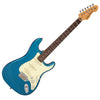When choosing a UHF wireless microphone system, it's essential to understand the differences between Channel 38 and Channel 70. Both are part of the UHF spectrum but vary significantly in frequency range, bandwidth, licensing requirements, and their suitability for various applications. This guide will help you make an informed decision based on your specific needs.
What Are Channel 38 and Channel 70?
Channel 38 and Channel 70 are UHF (Ultra High Frequency) bands used by wireless microphone systems. Understanding their differences can save you from potential interference and legal complications while ensuring the best performance for your wireless microphone setup.
Frequency Bands and Licensing: Channel 38 vs. Channel 70
Channel 38 (606.5 – 613.5 MHz):
-
Bandwidth: 8 MHz
-
License Required: Yes (Shared PMSE License from Ofcom)
In the UK, operating a wireless microphone system within Channel 38 requires a Shared PMSE license from Ofcom. This license permits up to twelve analogue microphone systems within the 606.5 – 613.5 MHz range. Operating without this license is illegal and may lead to penalties.
Channel 38 offers a larger bandwidth compared to Channel 70, making it ideal for professional events that require multiple microphones and minimal interference.
Channel 70 (863.1 – 864.9 MHz):
-
Bandwidth: 2 MHz
-
License Required: No (License-free)
Channel 70 is a license-free frequency band, making it accessible for general use without needing regulatory approval. This makes it an attractive choice for casual users or small events like karaoke and public announcements. However, its smaller bandwidth and widespread use increase the likelihood of interference from other devices.
Interference and Professional Use: Channel 38 vs. Channel 70
Channel 38:
-
Less Interference: Due to fewer users and its larger bandwidth, Channel 38 is generally less prone to interference, making it a more reliable choice for professional applications like concerts, conferences, and live performances.
-
Multiple Microphone Support: The wide bandwidth allows for more simultaneous wireless systems, making Channel 38 ideal for large-scale events that require many microphones.
Channel 70:
-
Higher Interference Risk: Channel 70 has a smaller bandwidth and is more crowded, leading to a higher risk of interference, especially in environments with multiple wireless devices.
-
Best for Casual Use: Despite the potential interference, Channel 70 is still a solid choice for general, non-professional settings like karaoke, speeches, and announcements.
Q-Audio Wireless Microphone Systems: Compatible with Channel 38 & Channel 70
Q-Audio offers a range of wireless microphone systems that are compatible with both Channel 38 and Channel 70, giving you the flexibility to choose the right system based on your needs.
Channel 70 Compatible Systems:
These systems operate within the 863.1 – 864.9 MHz range and are ideal for users who don't require a license to operate their system. Perfect for small events or personal use, these systems are easy to set up and use without needing to worry about licensing.
Channel 38 Compatible Systems:
These systems are designed to operate within the 606.5 – 613.5 MHz range and require a PMSE license for legal operation. Due to the larger bandwidth, these systems are more suitable for professional events where multiple wireless systems are required.
Additional Considerations for Channel 38 and Channel 70
-
Multiple Channel Usage: Channel 70 allows for up to four simultaneous wireless microphone channels, while Channel 38 can support more, depending on the specific frequencies licensed. This makes Channel 38 more suitable for events with multiple microphones or wireless devices in use.
-
Regulatory Compliance: Always ensure that you're compliant with local licensing regulations when using wireless microphone systems. Operating outside legal frequency bands or without the appropriate license can lead to fines and legal issues.
-
Future Changes in Regulations: Keep in mind that wireless microphone frequency allocations may change over time. In the UK, Channel 70 has been subject to changes in the past due to the need for the spectrum in other applications, like 4G networks. It's crucial to stay updated on Ofcom's regulations and any future changes to the frequency bands.
Conclusion: Channel 38 vs. Channel 70
Whether you choose Channel 38 or Channel 70 largely depends on your specific needs:
-
For professional use with multiple microphones and minimal interference, Channel 38 is the best option, though you will need a license to operate.
-
For casual or smaller events, where simplicity and ease of use are key, Channel 70 is an excellent, license-free choice, though you may experience more interference.
Understanding these distinctions between Channel 38 and Channel 70 will help ensure you select the right wireless microphone system for your event or application. Q-Audio provides a range of systems that are compatible with both channels, offering flexibility and quality for users at every level.





